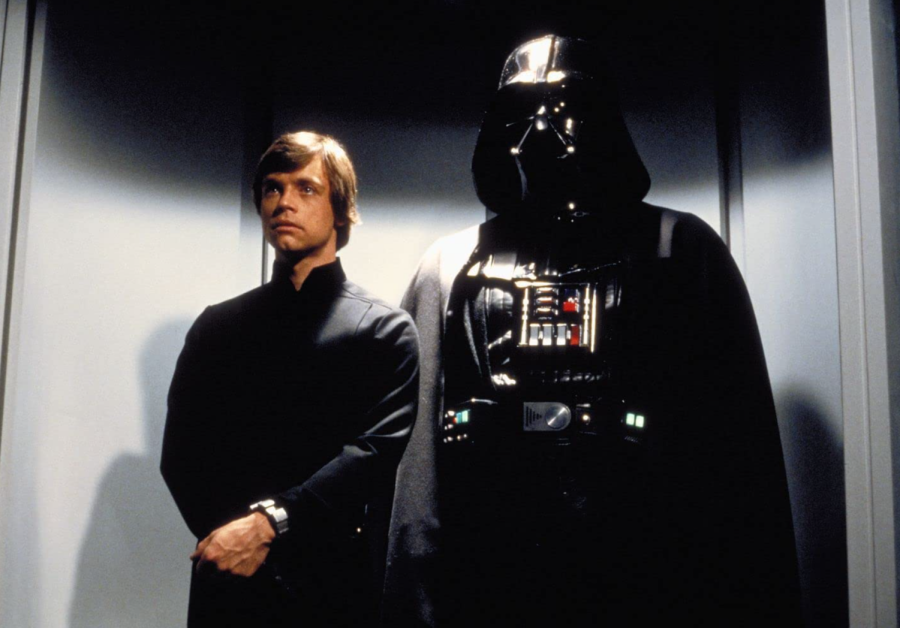‘Return of the Jedi,’ Star Wars franchise remain influential 40 years later
May 25, 2023
Today marks 40 years since “Return of the Jedi” capped off the original Star Wars trilogy. Written by Star Wars creator George Lucas and directed by Richard Marquand, the movie revolutionized film technology in the early 1980s.
“Return of the Jedi” provides an action-packed finale to the trilogy, with a total runtime of two hours and 15 minutes.
The plot picks up about a year after the events of the previous film, “The Empire Strikes Back,” with protagonist Luke Skywalker (Mark Hamill) venturing to his home planet of Tatooine to rescue his friend Han Solo (Harrison Ford).
Following the rescue mission, Luke and his friends volunteer to conquer the dark side of the force once and for all, with rebel forces attempting to destroy a brand new Death Star while Skywalker duels with villains Darth Vader (James Earl Jones) and Emperor Palpatine (Ian McDiarmid).
While it was originally to be shown in theaters on May 27, 1983, the film was released two days early in order to directly line up with the premier date of Lucas’s first Star Wars film, “A New Hope,” from six years before.
Get The Daily Illini in your inbox!
Part of what makes “Return of the Jedi” such a memorable film is the way that it revolutionized special effects for the rest of the sci-fi film world, writer Jeff Giles said in an editorial for Rotten Tomatoes.
The film was the first to popularize THX, which Giles describes as “an important audio innovation.” The audio quality assurance system has become an “industry-wide standard” for film studios.
Along with a need for high quality audio, the lengthy action sequences of the film required an abundance of special effects that were fairly new to the 1980s. As one of the first big space operas, Star Wars relied heavily on the use of a blue screen to make space effects look real.
The amount of action in “Return of the Jedi” is particularly extensive, as an entire new Death Star is created and destroyed, as well as several alien monsters being fought by primary characters.
Lucas was able to create robots and aliens with puppets and costumes for the film, instead of using animation as the more recent Star Wars films have done.
An article from Business Insider focuses on the tech behind Jabba the Hutt, a massive alien villain who Skywalker fights at the beginning of the film.
The article shows diagrams of how three people were able to fit inside the puppet. Additionally, a slightly smaller puppet was used for the film to portray Jedi Master Yoda (Frank Oz) .
The use of a real prop rather than a CGI figure could explain the higher ratings received by the older Star Wars films, the article said.
As the original trilogy was filmed before the creation of CGI, Lucas used model spaceships and camera tricks to create visual effects. This accounts for the film looking very different from space movies made in recent years.
However, Lucas has attempted to age the movie well. Since its original release in 1983, Lucas has inserted multiple edits into the film over time, including CGI aliens and add-in lines during a final battle scene.
A major change included the insertion of actor Hayden Christensen as Anakin Skywalker at the end of the film, which was done in 2004 to align the movie with the three prequels to the story created almost 20 years later.
The final installment of the original trilogy reached huge levels of success. According to film site The Numbers, which lists finances and budgets of most films, the movie made over 300 million dollars in the box office.
Adjusting for inflation, the film made over $900 million with 2023’s value of the dollar.
The site also lists “Return of the Jedi” as the highest-grossing film of 1983, surpassing runner-up “Tootsie” by over 100 million dollars.
“A New Hope” achieved the same in 1977, and the second installment of the trilogy, “The Empire Strikes Back,” also reached the top of the list in 1980.
Star Wars, a series of nine primary sci-fi/action films released over the course of 40 years between 1977-2017, has been regarded as a film franchise that “revolutionized entertainment,” according to Smithsonian.
The franchise was bought by Disney from Lucasfilm Ltd. in December 2012 for over $4 billion.
An article by AS USA on the selling of the franchise said that Lucas felt “it was time to pass the baton to a new generation of filmmakers.”
Disney has since taken the reins in creating three new Star Wars films, as well as adding all things Star Wars to their merchandise collections and theme parks.
A variety of spin-off films and shows have also been produced, all modeling after the original trilogy. These include hit Disney shows “Andor,” “The Mandalorian” and “Star Wars: The Clone Wars.”
Since selling the franchise to Disney, Lucas has had very little to do with the making of the more recent films and series. However, the original films such as “Return of the Jedi” were heavily influenced by his vision.
A 2018 article from Vanity Fair said one writer of the film argued heavily for lead character Han Solo to be killed off. Actor Harrison Ford supported this decision as well, reportedly because Solo “wasn’t part of the bigger story.”
However, Lucas’s wishes vetoed their opinions, and Solo was kept in the series to be used as a bigger plot device later down the line.
“Return of the Jedi” has been iconic to critics far and wide. As Urbana native critic Roger Ebert wrote in his review of the film just after its release, “the movie is a complete entertainment, a feast for the eyes and a delight for the fancy.”






